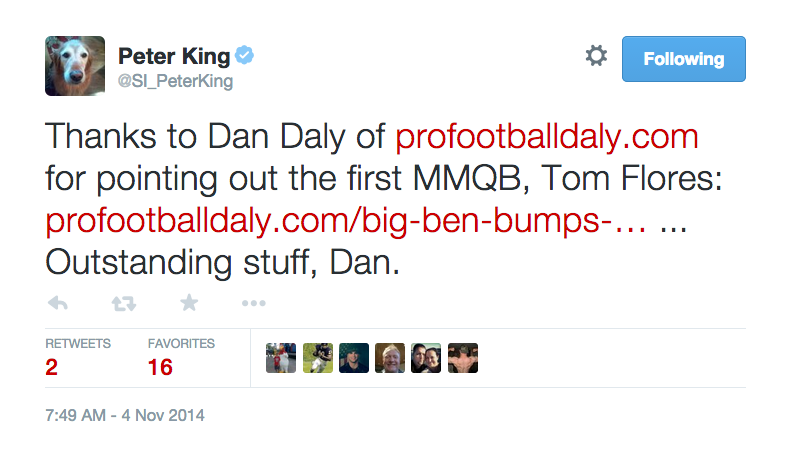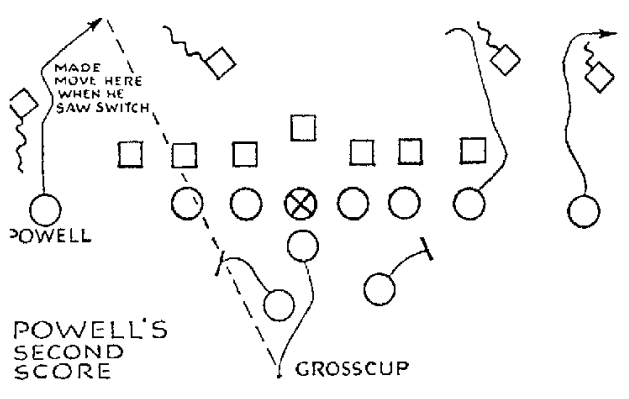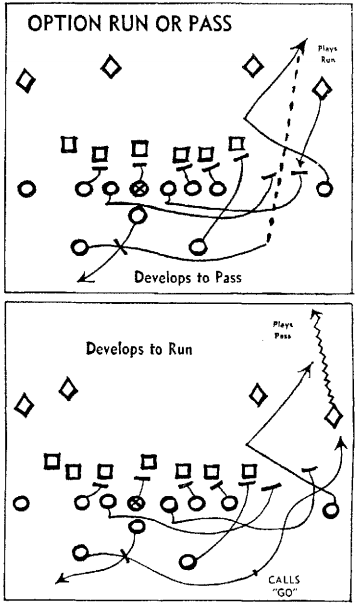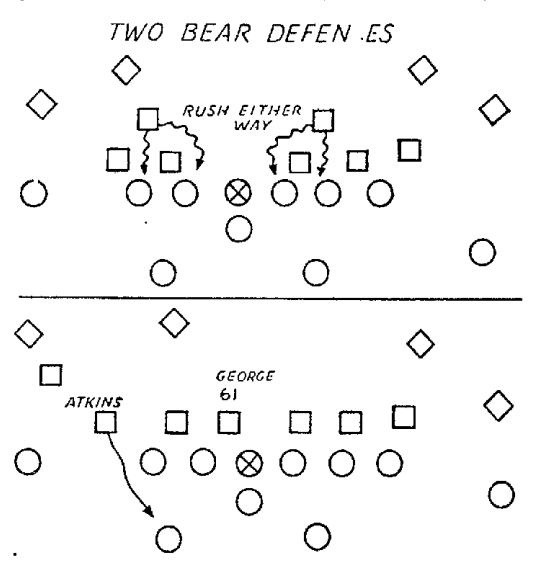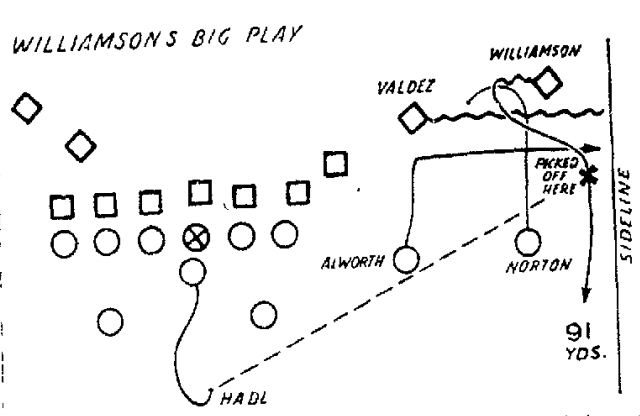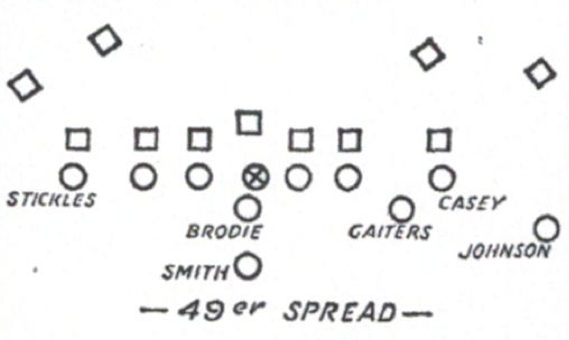My post on Tom Flores’ stint as the Oakland Tribune’s Monday Morning Quarterback in 1962 got some nice attention. Sports Illustrated’s Monday Morning Quarterback, Peter King, tweeted out a link to it, and the result, naturally, was a flock of new visitors to the site.
So I thought I’d follow up with a bit more from the Flores/MMQB file — more X’s and O’s, in particular.
Let’s start with his Sept. 10 column, after the Raiders dropped their opener to the New York Titans, 28-17. Flores:
New York’s secret was no secret — just the long pass. They scored all their points from outside our 20 and all through the air. Powell, New York’s spread end, made his touchdowns on a sideline-and-up and on a post pattern.
From where I sat it looked like his post pattern was not called in the huddle, and he confirmed this to the writers later. As he was running some other pattern downfield, our deep backs switched off to what was supposed to be a zone or switch-off between safety man and corner man. But our backs got confused and Powell adjusted his pattern into a post, hoping that [quarterback Lee] Grosscup would have enough time to spot the change. Lee did . . . and hit Art with a beautiful throw which put New York out in front 28 to 10.
The accompanying diagram:
On Sept. 15, with the Raiders off that week, Flores weighed in on the 49ers. One thing he touched on was the halfback option play:
Now that Bill Kilmer has been moved to running back [from quarterback], a new weapon will be introduced: the run-or-pass option. This play, with the right person running it, can be one of the most dangerous in football. [Frank] Gifford of the Giants and [Paul] Hornung of the Packers are perfectionists of this play.
It starts out like an end sweep, except the flanker, instead of blocking, fakes in as if he were going to block and then runs a corner pattern. The halfback runs it like he would any normal end sweep, only he has his eye on his flanker and the deep defensive back on that sideline. If the defensive back reads “run” and shoots up . . ., the halfback slows up and throws a nice soft pass so the flanker can run under it as he cuts to the corner.
Should the deep back read “pass” and stay with the flanker, all the halfback has to do is yell “go” and his guards will turn upfield as they would on an end sweep.
Two days later, following the Niners’ 30-14 loss to the Bears, Flores wrote about Chicago’s pass rush, which registered seven sacks for 64 yards and was essentially the story of the game:
[The Bears] had linebackers running in and out of spots in the line all day long, and most of the time they ended their assignments in [QB] John Brodie’s lap. Bill George, the great middle linebacker, and Joe Fortunato, outside linebacker, kept the 49er[s] offense confused. From a regular pro-type defense with four big men up on the line of scrimmage, they would jitterbug back and forth from various spots along the line and on the snap of the ball go shooting through on either side of the defensive tackles or ends. . . . On 90 percent, or so it seemed, of their defensive plays they shot at least one backer but more often two or three.
They used several types of defensive setups. One in particular seemed to really give the 49ers a rough time. On this defense George would get into the line in a regular lineman’s stance, and the rest of the linemen on the split end side would move out a couple of feet.
This left giant end Doug Atkins (6-8) outside the offensive tackle, and man did he come hard. He and Brodie got to know each other pretty well on a not-so-friendly basis.
On Oct. 1, Flores analyzed a 91-yard pick-six by cornerback Fred Williamson that had given the Raiders a 14-7 lead over the Chargers (in a game they ultimately lost, 42-33):
Fred actually intercepted a pass thrown for another man’s receiver. It went like this. San Diego lined up in a slot-right formation with [Don] Norton spread far out and [Lance] Alworth flanked inside, between Norton and the tackle. As the ball was centered, the outside man, Norton, ran up the field and curled in toward the middle, ending up in a deep hook pattern, at about 15 yards. Williamson went with him and had him covered.
The flanker, meanwhile, ran downfield and cut toward the sideline behind Norton at about 10 yards. This was [safety Vern] Valdez’s man, and he was right behind him ready to go for the ball. On the release of the ball, Fred left his man and went for the interception, cutting in front of Alworth. Somehow, Fred made a leaping catch that almost sent him to the turf, maintained his balance while he struggled to stay inbounds and then turned on his fine speed and outran the remaining Chargers who were coming over to lend a helping hand.
I could go on, but I’ll wrap it up with Flores’ Dec. 10 column. The 49ers had played Vince Lombardi’s Packers tough in a 31-21 defeat — they were up 21-10 at the half — and Tom was impressed with an offensive wrinkle they came up with for Green Bay, one that enabled Brodie to complete 13 of 15 passes in the first half (against a defense, I’ll just remind you, with five Hall of Famers):
The Niners came out with a new type of spread formation that gave the Packers fits the entire first half. With both ends tight, the flanker would spread to either side. On that side the tight end would spread out just about five yards and the halfback would slot in between the end and the tackle. This left only the fullback in the backfield in his regular position behind the quarterback.
From this formation the 49ers did several things. They would send the fullback in motion away from the strength, quick-toss to the fullback to the strength, fake a reverse to the halfback and throw a pass or give to the halfback on the reverse.
Clearly, Flores’ talents went beyond quarterbacking and coaching. His analysis in his Monday Morning Quarterback column was far ahead of its time — good enough to pass muster today. Even the Tribune’s diagrams, though primitive, painted a decent picture of pro football in the early ’60s.

